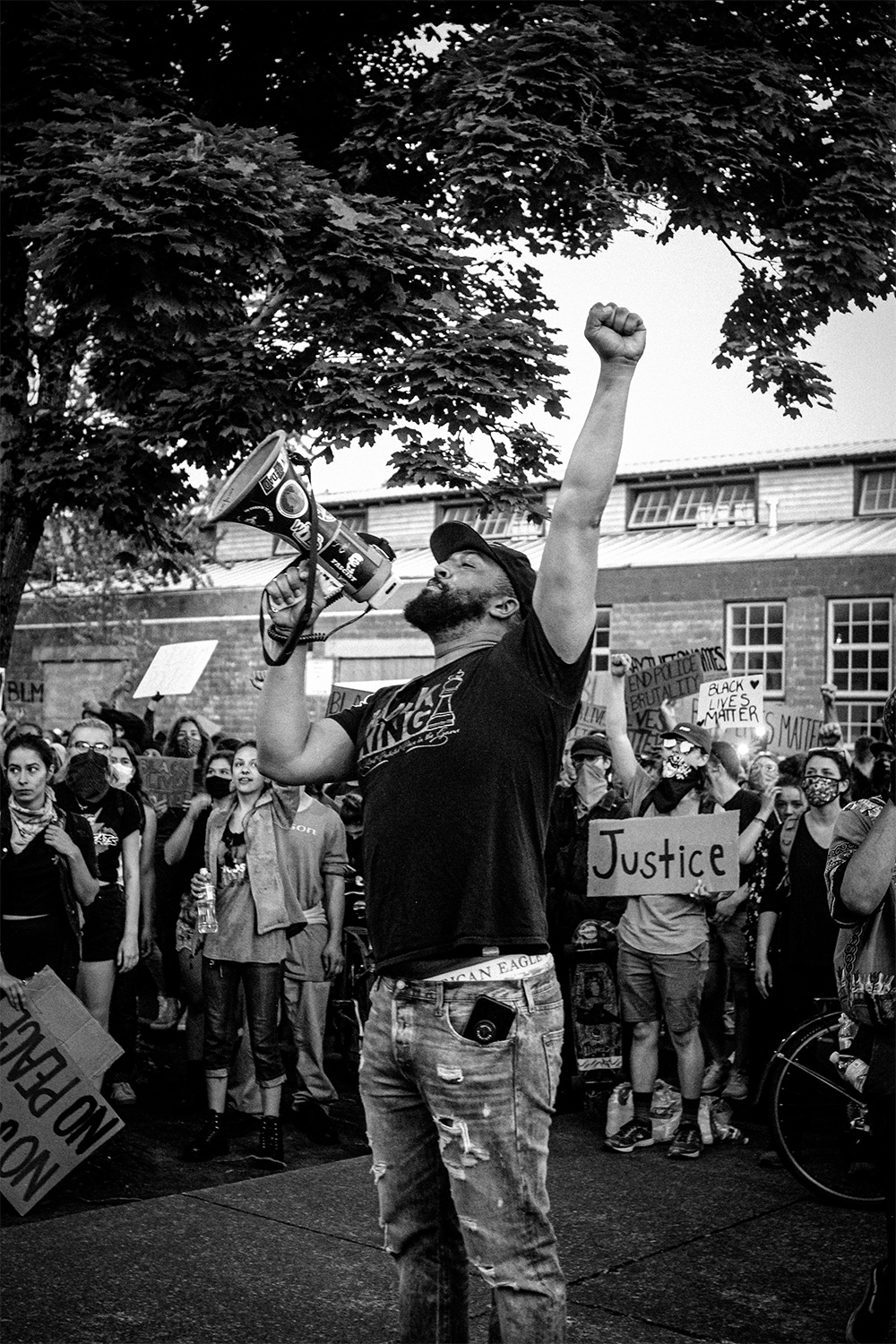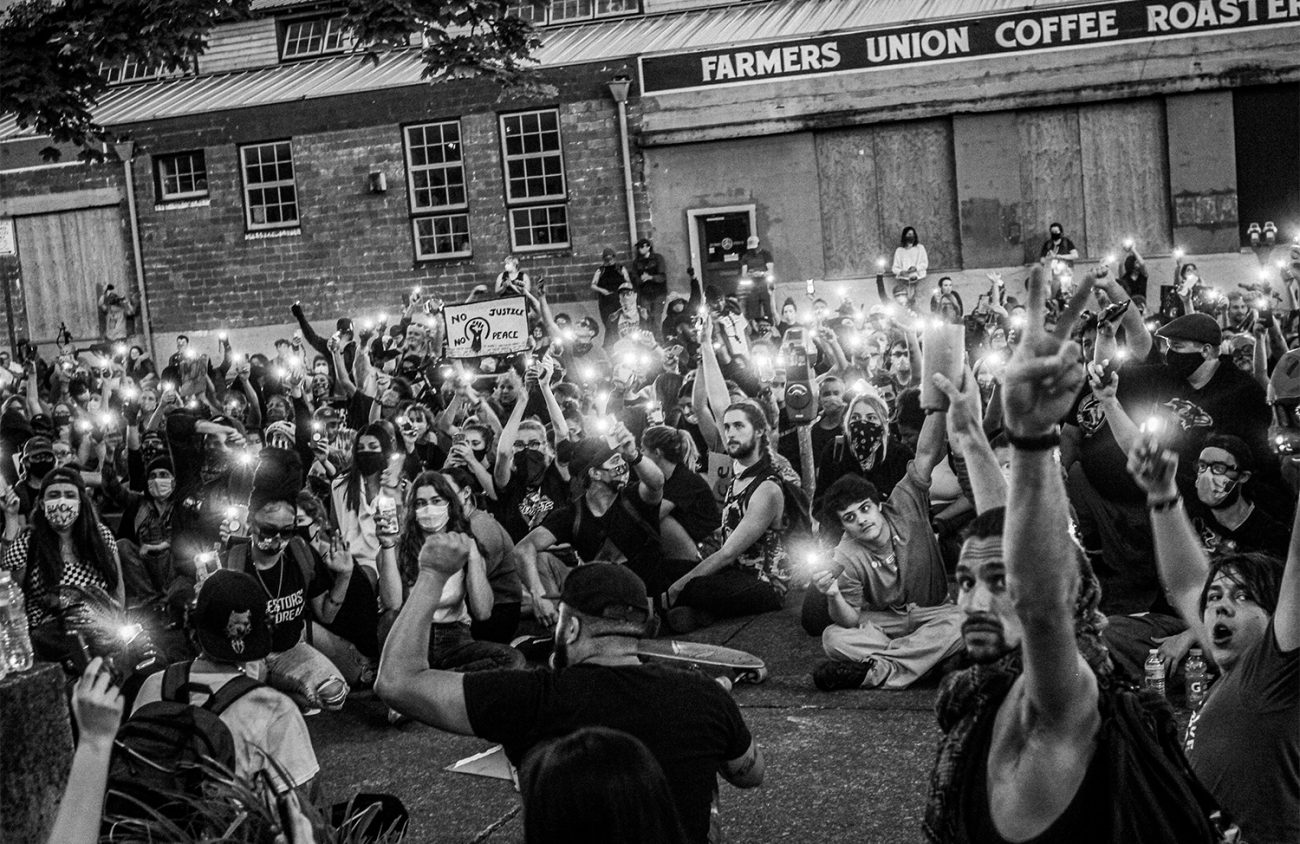By Taylor Perse, Frankie Kerner and Henry Houston
Sparked by the killing of George Floyd in Minneapolis, protesters have taken to the streets every day in Eugene since May 29 focusing on police brutality throughout the country.
After a chaotic first weekend that began with riots, included a peaceful Sunday rally, and ended with a curfew and tear gassing, the Black Lives Matter marchers have continued on. In the days following the initial protest, the group ventured through various neighborhoods of Eugene and Springfield. But the movement now has splits between those who want police reform and those who want to abolish the police completely.
Monday, June 1, was the first night of the protests that didn’t result in the Eugene Police Department tear gassing, arresting and shooting “extended range batons” (more commonly known as rubber bullets) at protesters. But the city did enact a curfew in downtown Eugene for the third night in a row. The marching began after a vigil for Floyd was held at Monroe Park.
Protesters skirted around the curfew boundary, but when they got too close they were met with the EPD SWAT team including their BearCat armored vehicles, while an EPD voice boomed over a loudspeaker.
“You are obstructing vehicular traffic on a public way,” the officer said. “This is a lawful command to disperse immediately. Failure to comply with this lawful order may result in your arrest.”
Shortly after, the city announced the curfew would be citywide at midnight, and the protesters continued marching until 11:50 pm, when they were told by organizers to go home.
On Tuesday, marchers met at the Wayne Morse Federal Courthouse and then marched through the streets of downtown to Free Speech Plaza, then to the Lane County Jail and back. The crowd continued to grow as time went on, with around 1,000 protesters at its peak. The march mostly stayed on the sidewalks, trying to be respectful of traffic.
The protest officially ended back at the federal courthouse, but some continued on, marching through the streets of downtown, through Franklin Boulevard, to the University of Oregon police station. The evening ended at Kesey Square, where protesters played drums and danced, occasionally chanting, intending for it to be more of a “celebration of life,” according to protest organizer Midas Well.
The following day, protesters met back at the federal courthouse. People spoke in front of the crowd before taking off toward south Eugene. The march went past Amazon Park and doubled back to the county jail. There, the tone shifted as hundreds of phone lights illuminated the air, while protesters took a knee and a moment of silence.
A few black activists spoke to the crowd, frustrated with how white people had been protesting. One black protester said, “When y’all dance, you dance on their fucking graves. I’m tired of seeing it; y’all think this is a fucking dance party?”
Another black protester said, “You want to uplift black voices? Then shut the fuck up and allow the voices of black people to be heard.”
On Thursday, the protesters met — once again — at the federal courthouse, beginning the evening with speeches after organizers said that only people of color could give speeches and start chants moving forward.
“When we march, people of color are in front and y’all come behind us,” organizer Moses Jackson said.
From there, the group got up and marched downtown to the Whiteaker neighborhood. Residents stood on their porch steps and in their front yard either clapping or filming.
“Out of your homes and into the streets!” the protesters chanted over and over, erupting in a cheer whenever someone would leave their house to join.
Protesters ended up at the 7th Avenue I-105 freeway onramp, where organizers told the group to lay down on their stomachs with hands behind their backs for 8 minutes, 46 seconds in honor of George Floyd.
While protesters were on their stomachs, some people in the backed up traffic grew impatient. One person yelled out their window “We’ve got to go home,” and some others honked their horns.
In response, after the silence, Jackson shouted from a megaphone, “That is why we have to do this.” He led the group over to the nearby businesses that were destroyed in last week’s riot and looting. Organizers took blame for what happened during the riot, and then pledged to help raise money to pay back the businesses.
On Friday, June 5, after marching from the federal courthouse to Matthew Knight Arena, Jackson listed three policy reform ideas that he wanted to push local police for and called for the resignation of EPD Chief Chris Skinner.
The first policy Jackson proposed was to build a citizen review board that would examine police files and have a final say on who could be a police officer. The city’s current Civilian Review Board offers input and oversight into citizen complaints and internal investigations by EPD, according to its mission statement.
The second was a policy of how police engage with residents during stops that is available for the public to see.
“I should know exactly what’ll happen when I get pulled over,” Jackson said.
The third action item was that the police chief should be elected by voters, not promoted from within or through an employment search.
When Jackson ran down the action items, a group of maybe 100 protesters walked out, chanting to defund, disband, dismantle the police. Before the smaller group left, people were loudly disagreeing with each other, which started when an older white woman spoke about how people should reclaim the U.S. flag from the “rednecks” who fly it from their pickup trucks.
With cloth banners holding up messages like “Get a real job, EPD,” the smaller group (which was named Black Indigenous People of Color, or BIPOC Liberation Collective) marched to the Lane County Jail.
One black woman protester who refused to give her name told EW that she and others left the larger group because the leaders there were being “performative for white people.” She added that the leaders at the larger Black Lives Matter protest were trying to be inclusive for white people.
“Are we there for all lives or for black lives?” she said.
The group stayed at the jail for a few hours while some speakers talked about dismantling capitalism, the system that enables the existence of police, as well as abolishing the police because the community can take care of itself. While at the jail, some protesters burned a U.S. flag, though they shielded the fire from the press.
Enlarge

Photo by Frankie Kerner
On Saturday, June 6, about 800 protesters marched throughout Springfield, walking through residential neighborhoods in the city center area. During the march, protesters asked Springfield police officers to take a knee with them — the officers didn’t — and told the officers they need more diversity and body cameras.
Isiah Wagoner, who’s one of the leaders of the larger local Black Lives Matter groups, Black Unity, told EW that Springfield has had similar rallies before — but it was for the Ku Klux Klan. So bringing the protest to Springfield was much needed, he added.
“This is 2020 with a different message,” he said.
He said that the city of Springfield didn’t want the protest to happen there. Police officers instead wanted a virtual protest.
“We want to be here,” he said. “We want to make voices known that if Springfield stands with Black Lives Matter and what it really truly stands for, then they wouldn’t have an issue of having us come down here.”
The route avoided Main Street (where a handful of white men were armed with weapons) because it’s mostly businesses and Wagoner, who developed the route, said he wanted to march through residential neighborhoods.
Asked about the split with the group that wants to abolish the police, Wagoner said the point of the movement is to “lift every voice.”
“We believe in human rights,” he said. “We believe in the rights that were given upon to us and want to protect other people’s rights.” The groups have continued to shift as philosophical stances coalesce.
Wagoner says he’s marched at Martin Luther King Jr. rallies, as well as LGBTQ protests. And he says he marched in the Million Man March in Washington, D.C.
“Just because this is our first time where we have a platform and our voices can be heard doesn’t mean it’s the first time that we’ve been out here for the community,” he says.
On Sunday, the new group, BIPOC, held its first rally at Free Speech Plaza, where it called for the defunding of the police. One activist criticized the other Black Lives Matter marchers, saying, “We will not be able to make a change against police brutality if our biggest ask is for them to take a knee.”
Members of BIPOC Liberation Collective have specified they do not want photos or videos of people’s faces without their permission, and told EW they did not want to speak to the press.
The protesters, now a group of about 1,000, went to UO campus and sat in front of Deady Hall, which was named for known racist Matthew Deady, an Oregon judge who held pro-slavery views and helped produce the document that banned black people from living in the state. Organizers shared some of the racist history and the issues facing people of color who attend and work at the university today.
Then the protest moved out of campus and up over Ferry Street Bridge to EPD headquarters on Country Club Road, where the group diminished to several hundred people.The building had been boarded up since the last weekend, and was covered in paper hearts and notes of solidarity and appreciation for the EPD.
Protesters were quick to rip off and throw away the hearts, replacing it with their own signs and spray painting “Fuck 12” on the wood, which stands for fuck the police; “ACAB,” meaning all cops are bastards; and “say their names,” referring to black Americans killed by police and other acts of racial violence. The protesters chanted “all cops are bastards” for a while, and a few of the organizers gave more speeches.
Then, they walked back towards Free Speech Plaza, spray painting anti-police messages on the side of the Coburg Road guard rail. The BIPOC Liberation Collective says it is just getting started.
The ongoing marches and protests have resulted in at least one victory so far.
As the city of Springfield tries to balance its budget over projected loss in revenue due to social distancing-related COVID-19, the budget committee decided to not fund police body cameras. The body camera program would cost the city $350,000 annually and would be projected to begin February 2021.
The committee made the decision after SPD Chief Rick Lewis said he would feel uncomfortable funding the program and then cutting police staff, according to city staff at the June 8 City Council work session.
However, after public pressure stemming from Black Lives Matter protests, as well as a rally organized by Johanis Tadeo of Springfield Alliance for Equality and Respect, the Springfield City Council and Mayor Christine Lundberg directed the city manager to fund the project.
